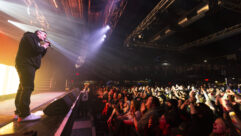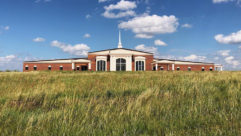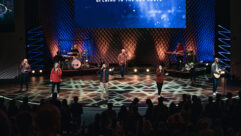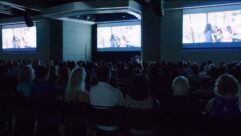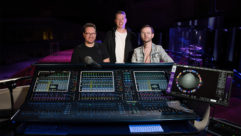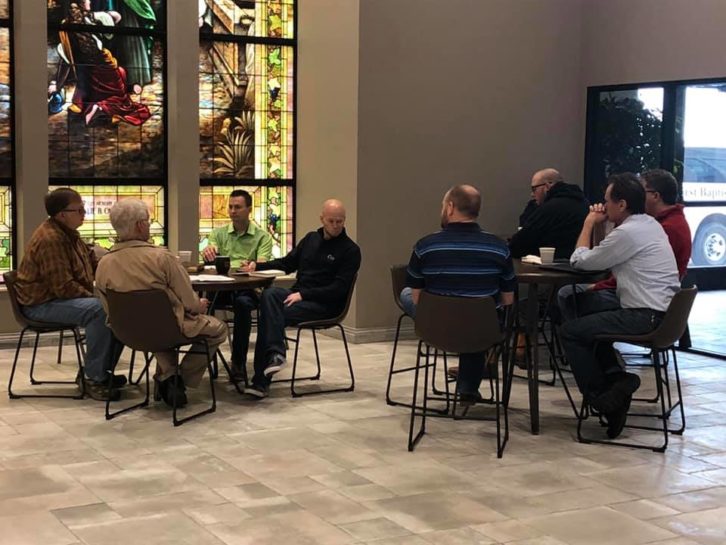 On this edition of the SVC Podcast, Contributing Editor Bennett Liles talks with Doug Hart of Hart Designs about the complete audio, video and lighting installation he did for the First Baptist Church of Cushing, Oklahoma. The worship facility is a brand new building with no previous wiring or other gear installed. Doug discusses the Danley sound system along with the Behringer front of house mixer and personal stage monitoring devices.
On this edition of the SVC Podcast, Contributing Editor Bennett Liles talks with Doug Hart of Hart Designs about the complete audio, video and lighting installation he did for the First Baptist Church of Cushing, Oklahoma. The worship facility is a brand new building with no previous wiring or other gear installed. Doug discusses the Danley sound system along with the Behringer front of house mixer and personal stage monitoring devices.
FOR MORE: GO TO PART 2
Links:
- Hart Designs, Etc … an AV design and integration firm in Yale, Oklahoma
- Danley SM80 molded energy horn
- Behringer x32 front of house mixing console
- Blackmagic ATEM TV Studio Pro HD Video Switcher
- Easy Worship software app
After planning it for years, the First Baptist Church of Cushing, Oklahoma got an all new worship facility. AVL specialists Hart Designs came in to outfit it from the ground up with video, sound and lighting. Doug Hart is here to tell us how it all got in and working during the construction. That’s all up next on the SVC Podcast.
Doug it’s great to have you here on the SVC Podcast from Hart Designs in Yale, Oklahoma. Thanks for getting with us.
Thanks for having me.
We’ve got a big AVL outfitting job to talk about for the First Baptist Church of Cushing. Now, how far away is Cushing, Oklahoma from Yale?
It’s not too far. I believe the church is about nine miles from my office.
OK, so pretty much a local job. No problem.
Right.
So before we get started on the church, tell us about Hart Designs. What kind of projects do you do at Hart Designs?
Well, we do turnkey projects; pretty much anything to do with audio, visual, lighting, projection, acoustic treatment, anything like that. We mostly work with churches and schools. We do some home theater, some commercial projects – restaurants, things like that – but the majority of our projects are churches and schools. [Timestamp: 1:19]
Ok so you’re experts on that. You know what to expect when you go into a church project. And I think you had the luxury on this one of getting to set up in a brand new worship facility. It was just being finished, right?
That’s correct. We got in actually when they were building the facility. We got to see the framing and everything going on there so we were in at the very beginning.
And that’s a big advantage.
It’s huge. A huge advantage. Yeah. [Timestamp: 1:42]
Knowing the layout right from the beginning and exactly what they wanted. I think there was a little bit of a change-up while you were in the process. But the congregation at the First Baptist Church of Cushing is very age-diverse so did that bring up any challenges in the way they do their sound control?
They are very age-diverse, but I really don’t know that it presents that much of a challenge. Like anyplace, our best goal is extremely intelligible audio. Everybody’s got to hear, you know, good coverage across the room. So on the audio side the age really doesn’t make a difference. They’re pretty good there about controlling their volume. They know where they want it, so we really didn’t have to worry about that. I think it was a big change for them as far as the look of things; the projection, the lighting, things like that that they’ve never had before. So there was some concern about the older congregation and how they would react to those new things. [Timestamp: 2:40]
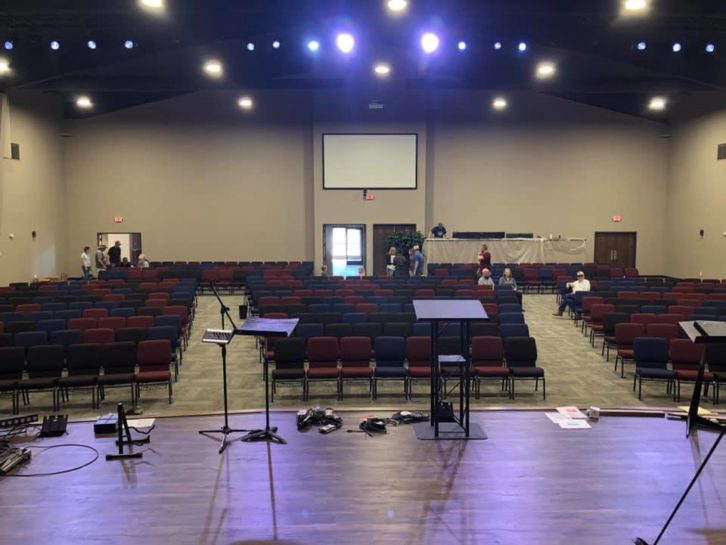
A lot of different video sources?
The larger-than-life video. They had never had any stage lighting before so this was a big change for them. The way I talked to them I said you’re in a new facility. Everything is going to be different, so I don’t think it’s going to be an issue. It’s not like we’re putting all this stuff in your existing facility and all of a sudden your facility has changed. You’re in a brand new building and everything is going to be different. And it turned out that that was the case. They were very pleased with the way things sounded, with the way things looked. No complaints as far as I’ve heard, anyway. [Timestamp: 3:17]
And I think you were going into this with an idea about a sound system to put in but then you decided to change horses after you heard a demo of the Danley system.
We did. We did. We had looked at a bunch of different systems trying to decide what was going to work best for this facility and within a reasonable budget. We were looking at the JBL column speakers and I’d done quite a bit of research on those, talked to some guys that installed them and got a lot of good feedback on that. I did not get the chance to hear them myself but that’s what we were looking at installing when we got in contact with Danley and had them come up and do a demo for us. I actually had another venue that we’re working on and once we heard them in that venue we had them come over after the church was to a point where we could have some reasonable idea what the room was going to sound like. We had them come and do a demo in the church and it took all of five minutes to sell them on these speakers. [Timestamp: 4:20]
So that demo was the clincher.
Yeah. Yeah.
OK so what do you have set up there? You have some SM80’s for the main house.
We do. We do. We have two SM80’s and two TH115’s. The SM80’s are flown left and right and the two TH115’s are together in the center. Up high they’re out of the way. They’re pretty much invisible. Keep in mind this is a, I believe, a 600-seat sanctuary. [Timestamp: 4:45]
I think six or seven hundred.
Yeah, somewhere around there. We’re using the two SM80’s and the two TH115’s and they’re barely touching them. It’s plenty. More than they’ll ever need. [Timestamp: 4:56]
And you have those running with a DNA 10k4 Pro amp. Where do you have the amp located?
They have an IT room. Behind the stage and on the second story there’s an IT room. It’s really great because we have everything in one location. So the amp is in a rack. I think we have a 42U rack in there that houses all of the equipment. [Timestamp: 5:18]
And they have a relatively big 65-foot stage I think.
Yeah. Huge stage.
Yes. A lot of room for the musicians and performers. When you first looked at this you considered some acoustic treatment. Did that end up not being necessary?
Well, not that it wasn’t necessary. The facility does need some acoustic treatment and they would benefit greatly from that. But when we talked about it, we talked about changing some designs in the beginning to eliminate some of the parallel walls and that didn’t happen. So we talked about some acoustic treatment after the fact and it’s one of those things that needs to be done but it hasn’t been done yet. Of course with the pattern control of the Danleys it’s not as bad as it could be and it does sound really good in there, but they would certainly benefit from some acoustic treatment. And we’ll probably do that in the future. [Timestamp: 6:06]
OK so you can save that for maybe a later phase of the project.
Right.
You had assistance in this. I believe it was from Beasley Technology.
I did. Beasley Technology and my company have worked together for quite a few years. Jeff Beasley is the owner of the company. Jacob Beasley is president there. We’ve all been friends for quite a few years, done a lot of projects together. Kind of consider ourselves sister companies. They are primarily an IT company. They do have a pro audio division, but they mostly focus on high school football stadiums, basketball gyms, things like that – 70-volt systems, classroom audio, things like that. But any time they’ve done larger AVL systems they’ve called me to help on this. And this job, actually Jeff Beasley attends church here and he’s part of the tech team and part of the worship team at this church. And we still had to bid this and win the job just like anybody else, even though he goes to church there. But Beasley Technology actually won the bid. Jeff called me. We designed the system together and they presented the bid and won it and then handed it off to me to actually do the installation. [Timestamp: 7:21]
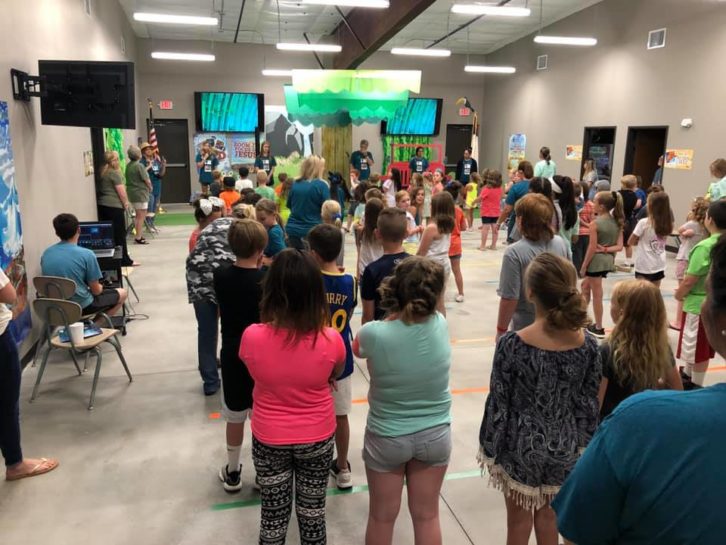
A part of this whole thing was the sound system and the central factor there is control. You have most likely a lot of volunteers working on the tech side of things. They got a Behringer x32 for the front of house. Was there a good reason as far as any particular features on it?
Yeah. There was a very good reason. They already had it.
[Laughs] That’s a good reason.
It is. They had purchased the x32, I want to say, two years ago, around in there. I actually installed it for them at their other facility. So they’d been using board for a couple of years. I actually recommended that they upgrade to the Midas M32. Same architecture and that’s what I use at my church and I prefer it. But they wanted to stick with the Behringer x32 because they were familiar with it and they wanted to do a redundant system. So they actually purchased another one that’s going in, I believe, the fellowship hall area, maybe the youth room. I can’t remember right now. But that way if something were to go wrong they can grab the other mixer, plug it in and continue on. So they wanted some redundancy there. [Timestamp: 8:28]
Well, that’s great that they already had it and everybody already knew how to work it.
Right.
And they knew its capabilities. Now, the stage monitoring also uses a Behringer system known as the Powerplay P16s?
Right. We used the Behringer personal mixers, the P16s. We’ve got eight of those on stage. So all the musicians, vocalists – I believe everybody that’s on the stage right now is using the P16s. Then they have a choir that comes on occasionally or they’ll come on for one or two songs and that choir, they’re using a couple of floor monitors. So I think there are 12 pockets in the stage with connections. They all have the capability of running either the P16s or a powered monitor. [Timestamp: 9:13]
And this church also does video of their events and services.
Right.
So describe the video system for us. What are the capabilities? I think you’ve got three JVC cameras.
We do. We have three JVC PTZ cameras; one at the back of the room, and one on left and right walls about halfway back in the room. It allows the camera operator to get his shot and then switch to that camera. The back camera can zoom all the way in on the baptistery so they can get a good shot of that and really see anything they want to in the room. [Timestamp: 9:47]
That might be a little tricky if you’re doing IMAG I think.
The IMAG works pretty well on it. If it was strictly an IMAG system we would have gone a different route, but they’re using it mostly for broadcast and then occasionally for IMAG. So it works out really well. [Timestamp: 10:04]
And you got the Blackmagic switcher for the video.
Right.
Is that something you selected or did they already have that, too?
No, that’s something that I recommended to them. The ATEM TV Studio Pro HD. It’s a great little switcher. It’s compact. It does anything that they would ever want to do and more. Fairly easy to use and the cost is great on it. It’s a good little switcher. [Timestamp: 10:29]
What was the timeframe on how you got all of this in there, connected and tested? This is a new facility and they’re not waiting on you but they can’t go until you have all the tech stuff in place.
Like a lot of new facilities we’ll get in and we’ll do as much as we can and then we’ll have to wait for construction on some areas. Then when that’s finished we’ll work that area and then we’ll have to wait on construction in other areas. So I believe the entire job ended up taking about six months or so, but like I said a lot of that was waiting on another crew. It was waiting on construction, waiting on electric, waiting on sprinkler systems – all kinds of things – heat and air; kind of work around the other crews. [Timestamp: 11:13]
A lot of people to try and get coordinated. I did notice one other thing on there that I’m not sure I was familiar with. The Easy Worship software. How does that work?
Easy Worship software. There are several presentation software companies. I would say Easy Worship and Pro Presenter are the two big ones. Pro Presenter is probably the biggest one with Easy Worship being second. But it gives them the ability to easily display on the projectors song lyrics, scripture, pictures, video – anything they want to display – where they don’t have to drag a window over to the extended screen. It does it for them automatically. So all of the songs that they use are in that software. All the scripture in many different translations is in that software. It makes it easy for them. And they were already facility with Easy Worship. [Timestamp: 12:06]
It’s obviously good that they were already familiar with some of the central elements of this system so they could get up and running pretty fast. As soon as you had everything connected and tested. Sounds like that went just fine and in Part 2 next week we’ll get into the lighting system and control and how you do the mics on the performers. It’s been great having you here. We’ve been talking with Doug Hart of Hart Designs on the complete AVL outfitting for the First Baptist Church of Cushing, Oklahoma. See you next week in Part 2.
All right. Thank you.
The First Baptist Church of Cushing has the entire new facility up and running with lights, video and sound by Hart Designs and they’re ready to stretch their event capability with all the new gear. Doug will be back with us next week to talk about their new lighting setup and their mic system. Be right here with us for that on the next SVC Podcast.


